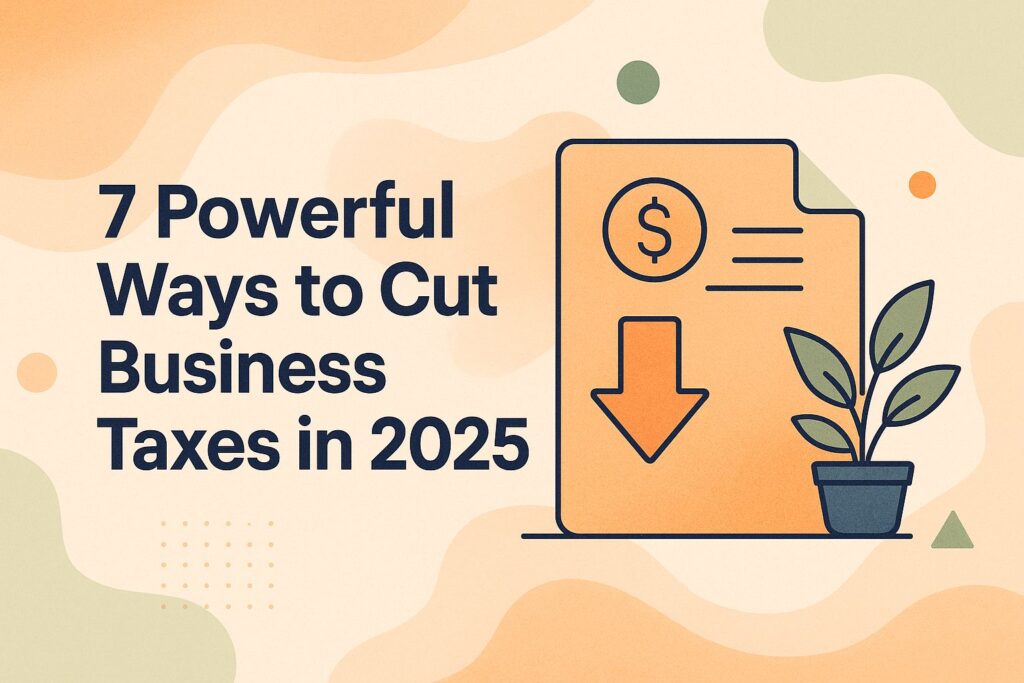
7 Powerful Ways to Cut Business Taxes in 2025
Tax season often brings a wave of anxiety for business owners, but it doesn’t have to. Cutting your business taxes can lead to significant savings, freeing up funds for growth and innovation. In 2025, effectively using strategic deductions, taking advantage of tax credits, and improving your business setup can significantly impact your success. Learn how to make the most of these opportunities and more as we discuss seven effective methods to cut your taxes and increase your profits.
1. Maximize Tax Deductions and Business Expenses
Taking full advantage of tax and expense deductions can significantly lower the income tax small businesses have to pay, allowing them to retain more money for growth, following tax laws, and everyday operations.
Common Deductible Expenses
Key deductible expenses for businesses include operational costs like salaries (average $50,000/year per employee), office supplies ($1,200 annually), and travel expenses ($1,500 per trip).
Other common deductible expenses include utilities, typically around $2,400 annually for small offices, and rent, with average costs varying from $12,000 to $30,000 depending on location.
Marketing costs, like online ads, are usually about $5,000 each year, which makes them a major tax write-off.
Don’t miss out on tax deductions that aren’t fully used, such as costs for employee training and education, which can average $1,000 per person and cover courses, seminars, or certifications.
By tracking these expenses diligently, businesses can maximize their tax savings.
Record-Keeping Best Practices
Good accounting practices and record-keeping can cut tax prep time by 30% and lower the chance of tax audits, which is important for business operations.
To follow best practices in record-keeping, begin by using accounting software such as QuickBooks. This software can handle many financial tasks automatically and costs about $25 each month.
Use tools like Expensify to sort your digital receipts, so they are easy to find when it’s time to do taxes.
Organize your records by expense type or project to make them easy to find. Arrange your files on a regular basis to stay organized. Set up alerts to check your files every three months.
These practices help reduce taxes and make audits easier.
2. Take Advantage of Tax Credits
Tax credits and economic incentives are useful options that lower taxes owed and can lead to big savings for companies in different industries, improving profit margins.
Types of Tax Credits and Corporate Tax Shelters Available
Businesses can access a range of tax credits, including the Research & Development Tax Credit (up to 10% of qualifying expenses) and Energy Efficiency Credits (up to $1,500).
Additional notable credits include the Work Opportunity Tax Credit, which offers up to $9,600 for hiring individuals from targeted groups, and the Small Business Health Care Tax Credit, providing up to 50% of premiums for employee health insurance.
For example, a tech startup spending money on new software could use the R&D credit to reduce development expenses. Similarly, a retail business upgrading to energy-efficient lighting might claim the Energy Efficiency Credit, potentially saving thousands.
Businesses should consult a tax professional to identify the best credits applicable to their operations.
Eligibility Requirements
Every tax credit comes with specific requirements, such as knowing IRS rules, following tax laws, and keeping detailed records to file claims correctly.
Common eligibility requirements for tax credits include:
- Maintaining a valid Social Security number
- Filing a tax return
- Demonstrating qualifying income levels
For example, the Earned Income Tax Credit requires proof of income, often shown through W-2 forms or pay stubs. Some credits, like the Child Tax Credit, necessitate documentation of dependent care expenses.
To avoid errors, keep your documents in order and submit them on time. You might use tax software like TurboTax or speak with a tax expert to avoid errors and increase your savings.
3. Use Retirement Contributions and Qualified Business Income Plans
Using retirement plans and strategic tax planning wisely can give great tax advantages, including tax benefits and payroll taxes efficiencies, and increase employee happiness and loyalty. For those looking to explore further, our Blog offers insights on maximizing these strategies effectively. If you’re outsourcing your payroll your provider should be able to help you with this.
Tax Benefits of Retirement Contributions
Businesses can deduct contributions to employee retirement plans, such as 401(k)s, reducing taxable income by up to $77,000 per employee in 2025.
For example, if a business contributes $20,000 to an employee’s 401(k), that amount is deducted from the company’s taxable income, resulting in substantial tax savings.
Contributions to traditional IRAs are also deductible, with individual contributions limited to $7,000 per person in 2025 ($8,000 if over age 50). These deductions can lead to improved cash flow, as they reduce the overall tax liability.
Always talk to a tax expert to understand and make the most of these retirement plans.
Choosing the Right Retirement Plan and Investment Strategies
Choosing a retirement plan means comparing choices like the SIMPLE IRA, which has low setup costs and allows you to contribute up to $14,000, and the 401(k) (higher limit, complex setup).
Plus the SIMPLE IRA and 401(k), consider a SEP IRA for self-employed individuals. This option allows contributions of up to 25% of your income, offering higher limits for business owners but requires extra administrative steps.
For small businesses with multiple employees, a traditional 401(k) can be advantageous due to larger contribution limits (up to $66,000 in 2025). Evaluate your business size and employee needs: a SIMPLE IRA suits businesses with under 100 employees, while a SEP IRA is ideal for freelancers.
Balancing these factors will help you choose the optimum plan.
4. Leverage Depreciation
Using depreciation lets businesses allocate the cost of assets over their lifespan, leading to significant tax savings annually.
Learning About Depreciation Methods and Cost Segregation
Common depreciation methods include Straight-Line, Declining Balance, and Section 179, with Section 179 allowing immediate deductions up to $1,160,000 in 2025, maximizing tax efficiency and capital gains management.
Straight-Line depreciation spreads out the expense of an asset equally over its useful life, which works well for items that decrease in value steadily and reliably.
In contrast, Declining Balance accelerates deductions, giving you larger early-year deductions, which is beneficial for rapidly losing value assets.
For example, if you purchase equipment for $10,000 with a useful life of 5 years, Straight-Line would deduct $2,000 annually, while Declining Balance might allow first-year deductions closer to $2,500.
Section 179 enables immediate expensing of qualifying equipment, drastically affecting your taxable income in the year of purchase.
Asset Management Strategies and Financial Forecasting
Proper handling of assets, like frequent checks and quick evaluations, can improve depreciation claims and strengthen financial well-being.
To maximize depreciation benefits, consider implementing these five strategies:
- Look at your belongings often to make sure their worth is correct.
- Use asset tracking tools like Asset Panda to see updates instantly;
- Schedule timely asset assessments after significant improvements;
- Categorize assets appropriately to take advantage of various depreciation methods;
- Keep diligent records of maintenance and repairs to support higher depreciation claims.
For example, a manufacturing company using Asset Panda reported a 20% increase in depreciation deductions after reassessing their machinery assets based on these methods.
5. Consider Business Structure and Legal Tax Strategies
Picking the correct business setup, whether LLC, S-Corp, or C-Corp, can provide important tax benefits and tax optimization strategies.
It’s important to understand the differences between LLCs and S Corporations. For new business owners, choosing between an LLC and a sole proprietor can also be crucial-our deep dive into LLC vs Sole Proprietor options explores which setup might be best.
Tax Implications and Tax Liability of Different Structures
An S Corporation can save business owners up to 15.3% on self-employment taxes compared to sole proprietorships, while LLCs offer flexibility but may incur self-employment tax liabilities.
S Corporations allow owners to pay themselves a reasonable salary and treat any additional profits as distributions, which aren’t subject to self-employment tax. This structure can lead to substantial savings, especially for higher earners.
On the other hand, while LLCs provide operational flexibility, members are generally subject to self-employment taxes on all profits, which can diminish tax benefits. For example, an owner earning $100,000 in an S Corporation might only pay taxes on their salary, such as $60,000. On the other hand, an LLC owner would pay taxes on the entire $100,000.
When to Change Your Business Structure
Changing business structure may be necessary when revenue exceeds $100,000 or when tax laws change, ensuring ongoing tax efficiency and compliance.
Other signs for restructuring include changes in business aims, such as entering new markets or offering different products.
If liability concerns increase, switching from a sole proprietorship to an LLC might be wise for added protection. Consider restructuring if you plan to bring in investors or partners, as a corporation can facilitate this process.
Always speak with a tax professional to learn how each option affects your taxes and to guide you in making informed decisions.
6. Engage in Strategic Tax Planning
Careful tax planning and tax management help businesses deal with complicated tax rules and find ways to save money during the fiscal year.
Importance of Year-Round Financial Planning and Tax Optimization
Planning for taxes throughout the year can lower surprise tax bills by up to 30% and improve how you manage your money.
- To better manage your tax plan and track expenses, review your taxes quarterly.
- Use tools like TaxAct to track important deadlines and IRS regulations, allowing you to easily manage your finances.
- Adjust estimated payments as your income fluctuates; this keeps you aligned with your overall tax obligations and tax brackets.
- Consider setting aside funds in a dedicated savings account to cover upcoming taxes, including tax liability reduction. This method helps you avoid surprises at tax time.
- Consult a tax professional annually to discuss any changes in tax law changes and tax reform that could affect your situation.
Working with Tax Professionals and Advisors
Working with tax experts and consultants can result in a tax refund that’s about 20% larger, thanks to their knowledge of tax laws.
Hiring a tax advisor helps you get the biggest refund possible and makes sure you follow tax rules and tax timelines, lowering the chance of audits.
When selecting the right professional, consider these factors:
- Verify credentials such as CPA, EA, or LLC designations.
- Evaluate their experience in your specific tax situation, including tax positions.
- Inquire about fees upfront, considering tax incentives.
For example, a CPA who works with small businesses can offer specific advice to help you save money on deductions, tax breaks, and write-offs. Ask reliable people for suggestions to find a specialist who matches your requirements, ensuring your financial health and business growth.
About the Author
Ethan Cole is a business growth advisor and serial entrepreneur with over two decades of hands-on experience helping startups and small businesses thrive. With a background in finance and operations, he’s led multiple companies from early-stage concepts to multi-million-dollar exits. Ethan specializes in scaling strategies, cost reduction, and building systems that support sustainable growth. As a content contributor for Kwote Advisor, he shares practical insights to help business owners make smarter decisions when launching, managing, and expanding their ventures.



